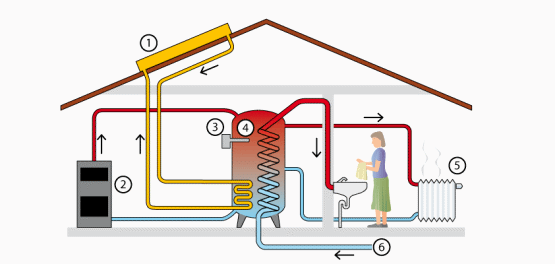Biofuel – wood or pellets
Wood is still the most common biofuel for private houses in Sweden. Pellets produce low emissions and are simpler and more convenient than wood.
Wood, pellets and other biofuels are regarded as renewable energy sources. Unlike fossil fuels, biofuels can be regenerated within the foreseeable future.
When wood or pellets burn, carbon dioxide will be emitted and will be discharged to atmosphere with the flue gases. Growing forests use the carbon dioxide for forming new biomass, and the carbon dioxide circuit is thus closed. So the carbon dioxide emitted when biofuels are burned does not contribute to increasing the amount of carbon dioxide in the atmosphere.
Combine with the sun
Wood or pellet firing and a solar collector is a good combination, since it will often eliminate the need for firing the boiler in the summer.

The picture above shows a biofuel-fired system supplemented with a solar collector. Item 1. Solar collector. Item 2. Boiler fired with pellets or wood. Item 3. Immersion heater. Item 4. Storage tank. Item 5. Radiator. Item 6. Cold water inlet. Illustration: Bo Reinerdahl
Storage tank
In a biofuel-fired heating system, it is also advisable to install a storage tank. The volume of the tank should be chosen to suit the heat demand of the house, the boiler rating and how often you are prepared to fire the boiler. In the system shown above, the storage tank is the heart of the system. The water in the tank is heated principally by the solar collector circuit, which is at the bottom of the tank, and then also by the biofuel-fired boiler. If the boiler and solar collector are unable for some reason to heat the water in the tank, the immersion heater at the top of the tank will be switched in to heat the water. The storage tank provides both domestic hot water in a separate circuit and heat for the water-based heating system of the house.
Environmentally marked equipment
There are tiled stoves, pellet or wood fired fireplace stoves, and wood and pellet fired boilers that have been awarded the Nordic Swan environmental mark. A Swan-marked sold fuel boiler is efficient and economical on fuel, it causes low emissions of environmentally harmful gases and ash, and is produced without the use of unnecessary toxins and metals.
A pellet-fired boiler, fireplace or individual burner can also be P marked. This marking is backed by the Swedish Testing and Research Institute (SP). Strict demands are made on performance, the environment, efficiency and safety before P marking is awarded. In addition, the manufacturer must meet the demands made on operating and maintenance instructions.
Advantages and disadvantages of burning wood
+ low fuel cost
+ renewable fuel
+ good supplement to electric heating
- own wood requires high work input
- requires storage space
- incorrect combustion and high humidity of the wood cause high emissions
Advantages and disadvantages of pellet firing
+ lower operating costs than electricity and oil
+ pellet stove is a good alternative to electric heating
+ renewable fuel
+ causes low emissions of environmentally harmful substances
+ requires low work input compared to wood
- requires storage space
- requires some attendance


